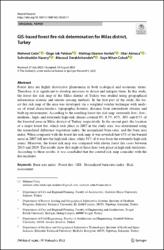| dc.contributor.author | Çetin, Mehmet | |
| dc.contributor.author | Işık Pekkan, Özge | |
| dc.contributor.author | Özenen Kavlak, Mehtap | |
| dc.contributor.author | Atmaca, İlker | |
| dc.contributor.author | Nasery, Suhrabuddin | |
| dc.contributor.author | Barış, Mesut | |
| dc.contributor.author | Çabuk, Saye Nihan | |
| dc.date.accessioned | 2023-11-01T19:05:31Z | |
| dc.date.available | 2023-11-01T19:05:31Z | |
| dc.date.issued | 2022 | en_US |
| dc.identifier.issn | 0921-030X | |
| dc.identifier.issn | 1573-0840 | |
| dc.identifier.uri | https://hdl.handle.net/11363/6171 | |
| dc.description.abstract | Forest fres are highly destructive phenomena in both ecological and economic terms.
Therefore, it is signifcant to develop measures to detect and mitigate them. In this study,
the forest fre risk map of the Milas district of Turkey was studied using geographical
information systems and remote sensing methods. In the frst part of the study, the forest fre risk map of the area was developed via a weighted overlay technique with analysis of stand characteristics, topographic features, distance from intermittent streams and
built-up environment. According to the resulting forest fre risk map, extremely low-, low-,
medium-, high- and extremely high-risk classes covered 0%, 0.5%, 65%, 30% and 0.5% of
the forested areas in Milas district of Turkey, respectively. In the second part, the location
of a major forest fre, which took place in 2007 in the study area, was determined using
the normalized diference vegetation index, the normalized burn ratio, and the burn area
index. When compared with the forest fre risk map, it was revealed that 45% of the burned
areas in 2007 fell into the high-risk class, while 51% of it was from the extremely high-risk
zones. Moreover, the forest risk map was compared with eleven forest fre cases between
2013 and 2019. The results show that eight of these fres took place in high-risk territories.
According to these results, it was concluded that the created risk map coincides with the
fre incidents. | en_US |
| dc.language.iso | eng | en_US |
| dc.publisher | SPRINGER, ONE NEW YORK PLAZA, SUITE 4600 , NEW YORK, NY 10004, UNITED STATES | en_US |
| dc.relation.isversionof | 10.1007/s11069-022-05601-7 | en_US |
| dc.rights | info:eu-repo/semantics/openAccess | en_US |
| dc.rights | Attribution-NonCommercial-NoDerivs 3.0 United States | * |
| dc.rights.uri | http://creativecommons.org/licenses/by-nc-nd/3.0/us/ | * |
| dc.subject | Burn area index | en_US |
| dc.subject | Forest fre | en_US |
| dc.subject | GIS | en_US |
| dc.subject | Normalized burn ratio index | en_US |
| dc.subject | Risk assessment | en_US |
| dc.title | GIS‑based forest fre risk determination for Milas district, Turkey | en_US |
| dc.type | article | en_US |
| dc.relation.ispartof | Natural Hazards | en_US |
| dc.department | Mühendislik ve Mimarlık Fakültesi | en_US |
| dc.authorid | http://orcid.org/0000-0002-8992-0289 | en_US |
| dc.authorid | http://orcid.org/0000-0003-4634-4864 | en_US |
| dc.authorid | http://orcid.org/0000-0002-5369-4494 | en_US |
| dc.authorid | http://orcid.org/0000-0001-9950-2833 | en_US |
| dc.authorid | http://orcid.org/0000-0001-5846-2476 | en_US |
| dc.authorid | http://orcid.org/0000-0002-7924-8396 | en_US |
| dc.authorid | http://orcid.org/0000-0003-4859-2271 | en_US |
| dc.identifier.startpage | 1 | en_US |
| dc.identifier.endpage | 22 | en_US |
| dc.relation.publicationcategory | Makale - Uluslararası Hakemli Dergi - Kurum Öğretim Elemanı | en_US |
| dc.institutionauthor | Barış, Mesut | |



















